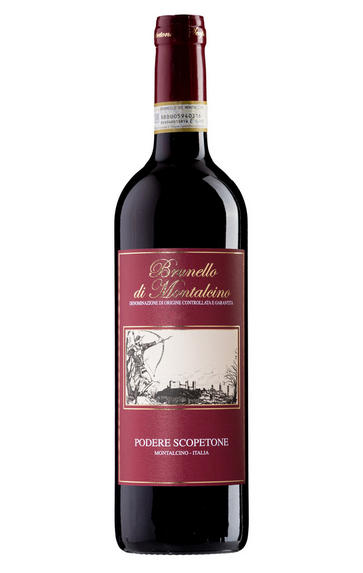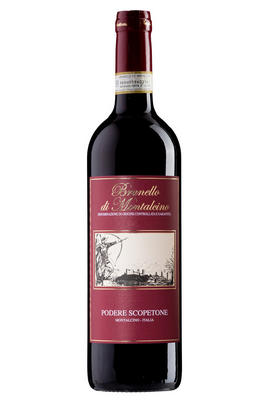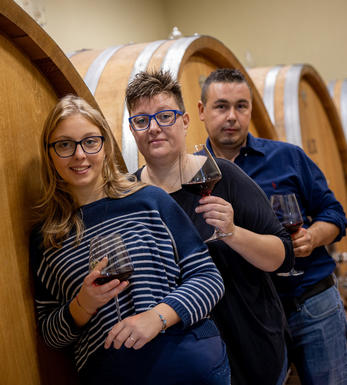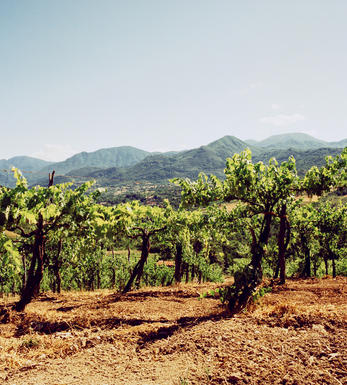
2019 Brunello di Montalcino, Scopetone, Tuscany, Italy

Critics reviews
The 2019 Brunello di Montalcino opens slowly in the glass, evolving with a blend of dried black cherries, spiced orange and hints of shaved cedar. It’s soft textured, nearly fleshy in feel, with a balancing core of tart wild berry fruits and brisk acidity. A gentle coating of grippy tannins lingers along with orange and inner rose notes as the 2019 finishes with medium length and youthfully tense.
Drink 2025 - 2033
Eric Guido, Vinous (November 2023)
Concentrated mid ruby with orange tinges. Rather closed and a little stalky/reduced on the nose. Supple cherry fruit accompanied by mellow creamy notes and firm tannins. Those tannins would have needed a little extra fruit power to be truly balanced.
Drink 2024 - 2030
Walter Speller, JancisRobinson.com (October 2023)
Sour cherries with orange peel and hints of vanilla bean. Some bark, too. Medium body, with very fine tannins and a fresh and bright finish. Lean and agile.
Drink after 2026
James Suckling, JamesSuckling.com (September 2023)
About this WINE

Scopetone, Tuscany
This is one of Montalcino’s hidden treasures. Unknown to many, Ferruccio Biondi – credited with “inventing” Brunello – planted his first Sangiovese on the best location he could find in the region. That was not the now-famous Tenuta Greppo estate, however, but rather the Scarnacuoia cru – where we find Podere Scopetone’s vines today.
This tiny, hallowed site, replanted in 1978, gives a taste of the region’s origins. Its soils are some of the area’s oldest due to the exfoliating exposure of this treacherously steep slope. Since local couple Loredana Tanganelli and Antonio Brandi acquired it in 2009, they have given new life and new meaning to Brunello’s original vineyard. They’re building a reputation for making some of the region’s purest, most desirable wines. Their total production is a tiny 2.5 hectares. They farm organically, though you won’t find certification on the label.

Brunello di Montalcino
Along with Chianti, Brunello di Montalcino is Tuscany's most famous DOCG and the region's boldest expression of Sangiovese. Located 30 miles south of Siena with the hilltop town of Montalcino as its epicentre, its 2,000 hectares of vines are naturally delimited by the Orcia, Asso and Ombrone valleys. Brunello is the local name for the Sangiovese Grosso clone from which Brunello di Montalcino should be made in purezza (ie 100 percent).
The Brunello di Montalcino DOCG has a whale-like shape: at its head, at 661 metres above sea level on ancient, stony galestro soils facing east and southeast lies the town of Montalcino, where the DOC was founded. As you follow the spine south towards the tail, the vineyards lose altitude – those around Colle Sant'Angelo are at 250 metres – while the soils become richer with iron and clay. Further east, in the shadow of the 1,734 metre Mont'Amiata lies the village of Castelnuovo dell'Abate where the vineyards are strewn with a rich mix of galestro, granitic, volcanic, clay and schist soil types.
Historically, the zone is one of Tuscany's youngest. First praised in 1550 by Leandro Alberti for the quality of its wines, it was Tenuta Il Greppo who bottled the inaugural Brunello di Montalcino in 1888. By 1929, the region had 925 hectares of vines and 1,243 hectares of mixed crops, while in 1932 it was decreed that only those wines made and bottled within the commune could be labelled as Brunello di Montalcino. Since then, the number of producers has risen from 11 in 1960 to 230 in 2006, while over the same period the vineyards have expanded from 1,000 hectares to 12,000. The region earned its DOC in 1966, and was upgraded to DOCG in 1980.
Brunello di Montalcino cannot be released for sale until five years after the harvest, or six years in the case of Brunello di Montalcino Riserva. During this time the wines should be aged for at least two years in oak, followed by at least four months in bottle (six months for Riservas); maximum yields are 55 hl/ha.
Rosso di Montalcino is declassified Brunello di Montalcino, released for sale 18 months after the harvest.
Recommended producers: Costanti, Fuligni, Lisini, San Giuseppe, Soldera, Cerbaiona

Sangiovese
A black grape widely grown in Central Italy and the main component of Chianti and Vino Nobile di Montepulciano as well as being the sole permitted grape for the famed Brunello di Montalcino.
It is a high yielding, late ripening grape that performs best on well-drained calcareous soils on south-facing hillsides. For years it was blighted by poor clonal selection and massive overcropping - however since the 1980s the quality of Sangiovese-based wines has rocketed upwards and they are now some of the most sought after in the world.
It produces wines with pronounced tannins and acidity, though not always with great depth of colour, and its character can vary from farmyard/leather nuances through to essence of red cherries and plums. In the 1960s the advent of Super Tuscans saw bottlings of 100% Sangiovese wines, as well as the introduction of Sangiovese/Cabernet Sauvignon blends, the most famous being Tignanello.


Buying options
Add to wishlist
Description
This is a careful selection from the Scarnacuoia vineyard, with the oldest vines planted in 1979. The ancient soils here are rich with volcanic influence and large fossilised shells – lending enchanting complexity and mineral bite to the final wines. The wine spends 36 months in large 33hl Pauscha botti, before 6 months resting in bottle. The wine is poised with great structural tension, whilst the glassy, red cherry and red berry fruit is generous and sweet. All this is underlaid with fresh, wild herbs and spicy tones. This is high-definition Sangiovese.
Drink 2025 - 2040
Berry Bros. & Rudd
wine at a glance
Delivery and quality guarantee